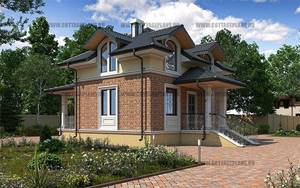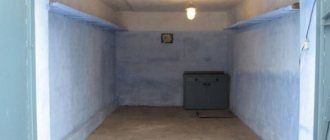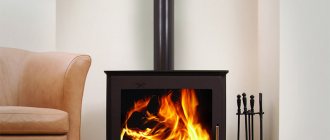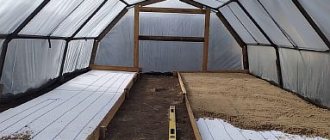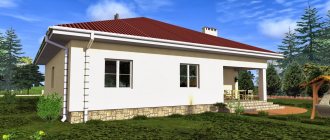It's time to decide on the type of oven
Depending on what you think your stove should be able to do, choose from the variety of stoves available today. And it is like this:
- Stove - "potbelly stove". No matter how funny it sounds, this is a very common option for a country house. Especially if the latter is not intended for year-round use. The “potbelly stove” is quite capable of warming a small residential or utility room, heating water and preparing simple food. Moreover, she is ready to do this without any special financial or labor costs on your part. In addition, stove heating using a “potbelly stove” does not require a lengthy preliminary design.
- Dutch oven. The most common type of heating stove in our country. The design feature of the “Dutch” is such that, despite its relatively small size, it has a relatively large heating area. Therefore, it is capable of heating up to sixty square meters of a room. At the same time, the same design features allow the “Dutch” to heat up quite quickly and cool down for a long time. Well, another advantage of this stove is its beautiful appearance. With the appropriate design, a Dutch oven can become a decoration for your home.
- Kitchen stove. Its purpose is obviously different from the functions of the “relative” described above. If you live in a village house that is decent in all respects, you cannot do without a solid fuel stove. She can prepare food, feed livestock, dry mushrooms and berries, and she can also simply heat water and keep it warm until the morning wash. There are three types of country kitchen stoves: a) simple, that is, without an oven and a hot water box; b) stoves with ovens; c) complex stoves with an oven and a water-heating box.
- Russian stove. The most famous type from fairy tales. And the most versatile: heats, cooks, steams, bakes bread, warms a bed for comfortable and therapeutic sleep. If you want, you can even take a steam bath in it, they say. And all this is so Russian, that is, without much hassle and all at once, at the same time.
Wood burning stove made of bricks
The most efficient oven is one that is made of bricks.
With the help of such a stove, the house is heated efficiently. Let's consider the main advantages of a brick kiln:
- The wood stove works without interruption. After all, electrical problems do not affect the operation of the furnace in any way. Therefore, it compares favorably with other heating devices. The wood stove will operate efficiently and without interruption at all times.
- Brick accumulates and gradually releases heat. A hob is often installed in a brick oven. Therefore, in cold weather you can use the oven for cooking. This way you can save money. After all, many homes have electric stoves that consume large amounts of electricity.
- In houses where other heating equipment is installed, a wood stove is installed as a backup heat source. After all, problems with electricity or other types of fuel often occur.
- A brick stove can operate on different types of dry fuel. You can use cardboard, coal, peat, branches, wood waste, etc. You can use modern fuel, which is manufactured for stoves operating on solid fuel.
Thanks to a large number of advantages, a wood-burning stove remains in demand today.
Types of plots
To design a house correctly, you should decide on the shape of the site:
- Square. If you are the owner of a square plot, then you are very lucky. This type is considered ideal for construction. The house will be located in the middle, and additional objects will be located on the remaining pieces of land around the building. If your site is located between two roads, then you should enter from the one that is less used.
- The plot is on a slope. To properly design a house, you need to calculate the difference between the highest and lowest parts of the site. If it does not exceed 8%, then standard design can be used. On a slope of more than 8% it is reasonable to build a basement. If the slope is more than 20%, then you should contact specialists to develop an individual house project.
- Narrow area. This is not the most convenient form of land. We will have to design the house very elongated, and also bring it as close as possible to the boundaries of the site, so that the remaining space can also be used.
As modern megacities grow, their average resident increasingly feels deprived of fresh air, free space, and personal space. That is why more and more of our compatriots intend to leave the city limits in order to retire for the weekend in their own village house.
The simplest options are small summer houses that do not require a heating system or wall insulation. But you can only relax in such houses during the holiday season.
An all-season house is suitable for year-round living, but its construction involves solving very difficult problems. The most pressing problem that will need to be solved is to ensure high-quality heating of residential real estate. The ideal solution in this case would be one that can solve the problem of heating a residential area, even in the most severe winter, cold weather. You can also use a fireplace to heat your countryside property.
The choice of one or another heating option for a living area depends on the individual needs of the owner. If between the quality of heating your home and sophistication and comfort, you chose the second option, then we strongly recommend choosing a fireplace. Its peculiarity is that it is capable of heating the room in which it is installed for only a short period of time.
The fireplace, despite the obvious shortcomings in the context of the heating system of a country house, is capable of creating a bright and beautiful fiery flame - an excellent solution for those who like to retire while reading a book, drinking tea, or philosophical reflection.
More practical house owners can be recommended to study in detail what the layout of a village house with a Russian stove is based on and what is included in this concept
And the first thing you should pay immediate attention to is the ability of a brick stove for a home to store heat for a long time. And this is not to mention the possibility of preparing many aromatic and satisfying dishes, which is simply impossible in a regular fireplace.
Therefore, it is not surprising that the vast majority of country house projects being developed include the presence of a Russian stove.
This version of a village house is simple in terms of execution and effective in terms of year-round use. We will dwell in more detail on the issue of planning a village house with a Russian stove in our next articles.
Home heating options
One of the oldest and most common methods of heating a home is the use of stoves and fireplaces, the choice of which depends on your individual needs. If between heating the whole house and the beauty and atmosphere of comfort you choose the second option, then you should give your preference to a fireplace. It does not heat for long, the heat it creates quickly evaporates, but it burns very brightly and beautifully - an ideal solution for those who like to drink tea and look at the fire.
A brick stove for the home, in turn, can store heat for a very long time. In addition, the good thing about a Russian stove is that you can cook a lot of tasty and aromatic dishes in it, which, of course, cannot be done in a fireplace. Therefore, in most cases, country house projects are developed with a Russian stove, since this option is the most convenient and easiest to implement.
An example of a traditional house layout with a Russian stove
Autonomous gasification requires a special permit, and the installation of a liquid fuel boiler requires the installation of a special container for diesel fuel that can hold at least three tons of diesel fuel. When building a simple country house, such large expenses will be very irrational, unless only if a large family will permanently live in the house.
Project of a small country house with a stove
Location of the stove in the house
The popularity of stove heating forces architectural bureaus to work on creating houses focused on this type of heating. The most interesting thing here is not only the size of the rooms, but also how the heating devices are located or located. This is how the central location of the wood-burning stove and the open spaces of studio rooms, which are so fashionable today, are most often used. Although there are also quite interesting projects with a combined heating system.
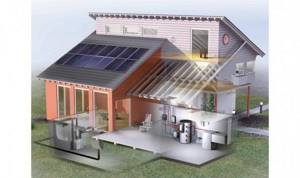
Layout of large houses for stove heating + additional heating
The idea of such a solution is quite interesting - the house is mainly heated with wood or coal, and if there is a need to heat individual rooms, then additional heating is turned on.
Electrical appliances are mainly used as additional heating devices; they are both more reliable and practical than gas or liquid fuel heating.
Projects of houses with a Russian stove
On the other hand, the size of the Russian stove simply does not allow it to be built in small rooms. Of course, dimensions matter, and this can be seen in the designs themselves. Greater heat transfer makes it possible to heat not only all the rooms on the ground floor; there is enough heat for the attic as well.
Many projects with a Russian stove are made in several versions, for example, when the stove has a traditional stove bench, or when, in addition to the firebox for heating, a hob with burners and an oven is also installed.
Examples of interesting layouts of houses with stove heating
So, one of these highlights may be a separate room - a library or a work cabin with a fireplace, or a sauna with a heater. Many will be interested in a solution such as a second light on a staircase passage or an open space of a glass wall in the living room, from which you can watch the landscape and admire the sunset.
And in these projects there is nothing that would prevent heating with a wood-burning Russian stove or a Swedish stove covered with tiles.
Construction of a house according to Vostretsov’s design
For simple and at the same time spacious houses designed by Vostretsov, stove heating fits perfectly into the concept of a modern house. Clear and at the same time light forms of buildings due to the large use of panoramic windows make it possible to significantly reduce energy consumption through the use of new technologies and modern materials.
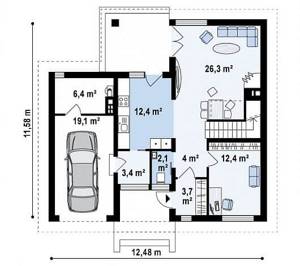
Multi-layer wall insulation and high-quality double-glazed windows perfectly retain heat, and the brickwork of the stove and its roughness ensures that a comfortable temperature is maintained even in the most severe frosts.
Kitchen design with Russian stove
Plan of the 2nd floor Currently, the design of a traditional Russian stove has several options, which depend on the household needs of a particular family.
So, modern stove designs for the home are:
- With a stove and flood chamber. The slabs, which are the hearth of the furnace, are built into an array of structures. In the classic version, they remain a blank space.
- With a fireplace.
With this option, it is possible to move the back wall of the Russian stove into another room using a partition. Such designs are considered quite practical, since they do not require the installation of an additional chimney outlet or a separate foundation for the fireplace. Brick stove-fireplace in a country house - With independent firebox and trestle bed. In the design of Russian stoves there is always space for a large bed, which can easily accommodate 2-3 people. In modern versions, the bed has been reduced, and an attached trestle bed has been added, which makes up for this lack of functionality. It is equipped with a full-fledged bed, while acting as an independent heating element.
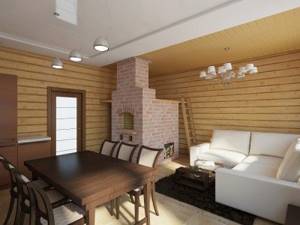
An example of a modern kitchen interior design with a small stove in the corner. It would be great if the kitchen, even at the design stage of the house, included large windows that would let in a large amount of natural light. To decorate this recreation area, you can use flowers in pots and vases, small paintings in wooden frames, dishes painted to resemble Gzhel and Khokhloma. If the size of the kitchen allows, then near one of the walls you can place a cabinet with shelves where sets and dishes will be stored.
We suggest you read: What is best for a bathhouse: aspen, larch, linden, cedar, alder, reviews
The food preparation area is arranged along one wall, along its entire length. Lower cabinets are usually used to store dishes and various kitchen utensils. Lower cabinets of different heights allow you to create a very unusual and interesting effect, which is sure to become a special, distinctive feature of your kitchen.
The smallest cabinet, which is located below all the others, is ideal for storing bags or cans. On the countertop you can place a couple of pots of flowers or even herbs - dill, lettuce or onions, which will significantly simplify the cooking process, because the necessary seasoning will always be at hand.
Layout features
To perform a successful planning, the following points must be taken into account:
- Foundation. The possibility of constructing several floors depends on its parameters. It must be durable and resistant to deformation.
- Wall thickness. When organizing several floors, the load on the walls and foundation is higher.
- Attic. When designing, it is necessary to ensure the reinforcement of the walls and to correctly draw up a plan for the rafter system.
- Arrangement of functional elements. A floor plan is being developed, indicating the installation locations for the stairs, stove, and fireplace.
- Availability of additional facilities. The foundation for a veranda or terrace is built taking into account the basic foundation, in order to avoid the formation of deformations of the supporting structures. This aspect is also noted in the layout.
- Interior decoration. Furnishing is also a major part of the layout. The furniture layout plan will allow you to create a variable base and choose the most successful option.
There are the following nuances regarding these rules:
- Storage cabinets are usually located against the walls.
- It is advisable not to break the geometry. The main spaces are built in the shape of a square and rectangle.

With oven
Installation of stove heating in the house
As the main source of heat, you can use ready-made stoves or build a brick structure yourself. At the same time, for the project of houses made of timber with stove heating, you can use both the first and second options. The most labor-intensive option is to build a stove yourself. But at the same time, already at the stage of the stove heating project, it is necessary to adapt the design for a specific house. The optimal layout scheme, its location in the room and the material of manufacture are selected.
The main features of heat supply with a brick stove are:
- Possibility to install a heat exchanger for organizing water heating;
- Installation of a system of air channels through which combustion products will pass before being removed through the chimney;
- Installation of a hob, oven, storage tank for hot water supply. These components will allow you to effectively use all the thermal energy from the furnace.
However, unlike gas heating projects for a private home, it is necessary to think in advance about where the fuel will be stored. It should not be in the same room as the stove.
Preparatory work for organizing heating
For the practical implementation of the heat supply system project for a two-story house, a number of preliminary measures should be carried out. If you plan to make your own stove, build a separate foundation for it.
This is due to the large mass of the structure. A concrete floor, much less a plank floor, will not support the weight of the stove and it will warp and settle. Even a small project of a rural house with stove heating must take this fact into account. It is best to arrange the foundation during the construction stage of the building.
The base layout for the furnace is in many ways similar to a standard slab foundation. But experts note a number of features that should be taken into account when drawing up a project for houses made of timber with stove heating:
- The upper plane of the finished foundation should be 70 cm below the floor;
- The dimensions of the base are 30-40 cm larger than the dimensions of the oven;
- The foundation of the stove should not be connected to the common building.
After this stage, you can begin construction of the furnace. In advance, a detailed order is indicated in the design of a house with stove heating.
Laying a heating stove in a house
After the foundation has completely dried, a heat-reflecting material – aluminum foil – is installed on its surface. Additionally, you can install a layer of insulation. The only limitation when choosing a material is that it should not be flammable.
In a typical heat supply project for a two-story house, special attention is paid to the materials used for the construction of the stove. In places of greatest thermal impact, only refractory fireclay bricks are used
All other components of the structure can be laid out of ordinary brick.
If you have no experience in implementing a furnace heat supply project, it is best to entrust the construction of the structure to professionals. But if you wish, you can do this yourself. It is recommended to make several test layings first. For construction you will need the minimum set of a mason - a trowel, a trowel, a level, a plumb line. Additional materials should be included in the design of houses with individual heating:
- Scaffolding. May be needed at the final stage of construction, when the height of the structure is more than 2 meters;
- Nichrome wire is used to install the door and grate.
Upon completion of work, the draft level should be checked. To do this, you can take A4 paper and attach it to the hood. It should “stick” to the hole.
Consultation with specialists
|
29-52
you are considering belongs to a series of houses -
Avis Satura.
The house project was designed using gas silicate blocks
.
Kerakam Cayman30, as the material for load-bearing walls.
.
Cayman30 ceramic block is used as the load-bearing wall material
, presented in our catalog under number
92-52
.
Cayman30
ceramic blocks are superior to gas silicate/aerated concrete blocks
in all main characteristics: strength, heat conservation.
At the same time, the final costs will be lower when choosing ceramics
. For more information on this, see the comparative cost calculation below.
Application of ceramic blocks Cayman30
allows you to build country houses that meet all current standards, and in particular, those that meet SNiP “Thermal protection of buildings” for cities such as:
- Ekaterinburg,
- Novosibirsk,
- Permian,
- Krasnoyarsk
,
without
a weak link
in the design of the external wall - a layer
of insulation
.
At the same time, the cost of constructing one square meter of housing will be one of the lowest when compared with any stone block, including in comparison with gas silicate blocks.
Projects of houses made from ceramic blocks are included in the House Project promotion for free
.
Cayman30
ceramic blocks from our company, we will refund you the cost of the design documentation you paid for.
Unusual ideas
Since it makes no practical sense to completely recreate ancient life in modern conditions, some items of the latest technology can simply be decorated as antique. For example, an ordinary niche in the wall can be given the appearance of a voluminous cabinet from floor to ceiling with the help of pylons and cornices. Doors made of artificially aged wood and decoration with friezes and borders will create the appearance of a free-standing product in an antique style.
One of the options for decorating a house in the Russian style can be a fake facade, which will look completely like a Russian hut. For example, if you buy a real old house with carved decorated frames on the windows, a massive oak door and a lighthouse under the roof.
Heating system
Experienced designers begin designing a home by designing a heating system. This may not be so relevant for country summer houses, but if you plan to live outside the city for a long time, then you cannot do without a stove in the cold season. Among the many modern heating options for the Russian style, a classic Russian stove is suitable. It will not only become the main accent of the interior, but will also serve as an inexpensive source of heat.
Electric heating is not cost-effective for a country house, gas heating is not always possible, and a properly located wood stove can heat the entire room even in the most severe frosts.

Stove heating will be effective only if the stove is installed in the center of the building and is in contact with each of the rooms. Therefore, in the classic layout of a Russian hut, the stove is installed in the walls between the rooms. It is best to place the firebox in the corridor or living room-kitchen adjacent to the corridor. This will make it more convenient to bring in firewood, keep the rooms clean, and not disturb vacationers in the rooms.

A centrally located large stove is preferable to several small ones, as it allows heat to be evenly distributed throughout all rooms and significantly saves fuel consumption.
If the house does not involve division into rooms, then the stove will become a natural space divider, zoning it into functional parts. In two-story houses, installing a stove requires certain safety precautions. It is necessary to consider the construction of reliable floors between floors.
Also at the planning stage, the option of the stove itself and its functions is selected. This can be a Russian stove with a hob, with a stove bench, or a decorative stove that serves only to heat and decorate the home.
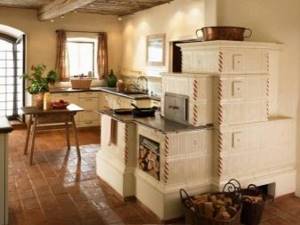
Features of a heating stove on two floors
It is important to know exactly what the weight of the future heating system will be. To build a reliable structure, it is necessary to pour the foundation
It must be deepened into the ground by at least 1 meter, and the ceiling between the first and second floors must be very strong. A reinforced concrete slab can support this weight. Installation of such structures should be carried out along internal load-bearing walls.
A two-story stove can be of two types - a stove with one firebox or with two. The main firebox in such structures can only be on the ground floor, as well as all heavy extensions - a stove bench or stove. A fireplace may be installed on the second floor - sometimes false, but more often functional. A false design will increase the heat transfer of the heating system, and the current one will allow you to warm up the room faster. Such systems include two-channel chimneys.
Stove with one firebox
A heating system with one firebox may last less than two fireboxes. This happens due to the specific design of the system itself.
On the top floor there should always be channels located vertically. In order to separate the heating of the floors, dampers are installed.
Their function is to block the movement of flue gases. After this, the cooling gases in the chimneys of the second floor form condensate. thus, the masonry begins to gradually collapse. The design of a stove in the house with two fireboxes can provide faster heating.
On average, the size of the firebox of such a stove is designed for a single loading of up to 50 kg of dry firewood. Typically, for stoves with one firebox, the logs are stacked vertically. This allows for faster heat transfer. The gases rise up the first ascending chimney, then, at a height of about 3 meters, the gases are separated into the distribution chimneys of the first or second floor. There may be bricks protruding inward inside the vertical channels. They allow you to increase the surface area that absorbs heat.
In places where there may be an accumulation of soot or ash deposition, special openings for cleaning should be provided, but closed with doors. A heating system with a single firebox has a big advantage. You only need to heat on the first floor. No need to carry firewood upstairs and do the same thing twice.
Fireplace design
Such structures are very similar to a fireplace from the outside, but inside they have the same number of smoke circulation channels as in a stove. Combining a fireplace and stove is not something new. This hybrid design has been used in everyday life for quite some time. Its main difference is that it is able to retain heat in the house for 18 and even 24 hours. The heat transfer in such furnaces can reach 5 kW, which is twice as much as in conventional units, and this figure allows you to save on fuel. This result can be achieved by using fireclay bricks in masonry. There are smoke channels on three sides of the firebox, which allow the surface to be heated evenly.
As a rule, a fireplace stove takes up much less space in the house. than the classic one, and visually this design looks quite attractive.
But when choosing such a system in your home, it is important to understand that installation and material costs may be more expensive due to the firebox doors - which can be made using fire-resistant glass, or due to the design idea. Very often, a stove is located above the firebox, presented in this building as a fireplace.
It is very convenient to bake here, but unfortunately, in this design the heating system is the main one, so there is no hob here
Very often, a stove is located above the firebox, represented in this building as a fireplace. It is very convenient to bake here, but unfortunately, in this design the heating system is the main one, so a hob is not provided here.
Stove heating of this type for a two-story house, although it has advantages in heat accumulation compared to others, still will not provide as much heat on the second floor as on the first. It is better not to build such a structure yourself, but to entrust it to professionals.
Stove heating for a two-story house located outside the city or in the countryside may be the only possible option. The high cost of electricity and frequent interruptions cannot provide inexpensive and efficient heating in the house. The use of natural gas is also not always possible, because access to it is not available everywhere, and using propane in cylinders for heating is not profitable and may be unsafe.
Layout
There are a lot of options for planning a 6x6 one-story dwelling with a heating system. The most common plan for such a house is as follows:
- Bedroom 8 m2;
- The stove has a firebox on the kitchen side, but its walls open onto the living room and bedroom;
- Toilet;
- Hallway.
The design of such a house may vary depending on the user's requirements. But the main thing is that the stove structure should be located in the very middle of the home and be built into the internal partitions. If it is located across the wall from the common room, then its layout is such that it can be heated by the corner of the stove. Professional calculations have shown that one stove can successfully heat three rooms located around it.
To heat living spaces larger than 6x8 or 6x9, it may turn out that one stove does not fully cope with its function.
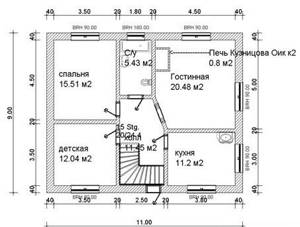
Project with a 9×11 house layout with a Kuznetsov stove
Then, for example, a village house was equipped with a small, tall stove for heating, which was completely unsuitable for cooking. For a medium-sized country house, and especially with an area of 8 x 8 in a frosty winter, it will also not be superfluous.
Both buildings are square in shape and differ only in three square meters. Therefore, the development drawing will have only minor deviations. But the 6x8 house has a completely different design, because, unlike, it is a rectangular building. Here you can increase the kitchen area to install a larger oven. After all, it must heat a home with walls that are not equidistant from it. The drawing of a 6x9 building also differs little from the drawing of a 6x8 building. But for a living space, every meter of space increases the comfort of living. At the same time, it increases the overall cost of construction. However, in any case, stove heating is the most affordable and economical way to keep a private home warm.
The layout of a 6x6 house with an attic must be carried out not only taking into account building codes, but also in compliance with other requirements. Proper organization of design work will allow you to build a comfortable building. In addition, it will enable owners not to spend extra money when purchasing building materials.
Layout of all floors of a 6x6 house with an attic
Often, when starting a project, many masters make the same mistake. They are building a full-fledged one with many rooms. But when winter comes, followed by energy bills, a sobering moment comes. You can avoid unnecessary expenses during the construction and further operation of the house by choosing in advance the type of house 6x6 with an attic for construction.
What is the difference between an attic and a traditional second floor? During its construction, no money is spent on construction and. Which in most cases is practically not used by the owners of the house. Therefore, in addition to the costs of heating and maintaining the premises, the costs of maintaining the attic are added.

Layout option for a 6x6 cottage with an attic
An attic is a properly organized space under the roof that is used for the benefit of all family members. With proper insulation, heat will not escape through the roof slab. By the way, many craftsmen make windows in slopes, which allow you to save on artificial lighting.
But the main advantage of this type of construction is that much less construction and finishing materials will be spent during the construction of the facility. And therefore money from the family budget.
Natural circulation scheme
To understand the principle of operation of the gravity system, study the typical diagram used in two-story private houses. Combined wiring is implemented here: the supply and return of coolant occurs through two horizontal lines, connected by single-pipe vertical risers with radiators.
How gravity heating of a two-story house works:
- The specific gravity of the water heated by the boiler becomes smaller. The colder and heavier coolant begins to displace hot water upward and take its place in the heat exchanger.
- The heated coolant moves along a vertical collector and is distributed along horizontal lines laid with a slope towards the radiators. The current speed is low - about 0.1-0.2 m/s.
- Dividing through the risers, the water enters the radiators, where it successfully releases heat and cools. Under the influence of gravity, it returns to the boiler through a return manifold, which collects coolant from the remaining risers.
- The increase in water volume is compensated by an expansion tank installed at the highest point. Typically, the insulated container is located in the attic of the building.
Schematic diagram of gravity distribution with a circulation pump
In modern designs, gravity systems are equipped with pumps that accelerate circulation and heating of rooms. The pumping unit is placed on a bypass parallel to the supply line and operates when electricity is available. When the light is turned off, the pump is inactive, and the coolant circulates due to gravity.
Scope of application and disadvantages of gravity feeding
The purpose of the gravity circuit is to supply heat to homes without connection to electricity, which is important in remote regions with frequent power outages. The network of gravity pipelines and batteries can work together with any energy-independent boiler or stove (previously they said steam) heating.
Let's look at the negative aspects of using gravity:
- due to the low flow rate, it is necessary to increase the coolant flow by using large-diameter pipes, otherwise the radiators will not warm up;
- in order to “spur” natural circulation, horizontal sections are laid with a slope of 2-3 mm per 1 m of the highway;
- healthy pipes running under the ceiling of the second floor and above the floor of the first floor spoil the appearance of the rooms, which is noticeable in the photo;
- automatic control of air temperature is difficult - for batteries you need to buy only full-bore thermostatic valves that do not interfere with the convective circulation of the coolant;
- the scheme is unable to work with heated floors in a 3-story building;
- An increased volume of water in the heating network implies prolonged heating and high fuel consumption.
To fulfill requirement No. 1 (see the first section) in conditions of unreliable power supply, the owner of a two-story private house will have to bear the costs of materials - pipes of increased diameter and cladding for the manufacture of decorative boxes. The remaining disadvantages are not critical - slow heating is eliminated by installing a circulation pump, lack of efficiency - by installing special thermal heads on radiators and insulating pipes.
Design Tips
If you have taken the development of a gravity heating scheme into your own hands, be sure to consider the following recommendations:
- The minimum diameter of the vertical section coming from the boiler is 50 mm (meaning the internal size of the nominal diameter of the pipe).
- The horizontal distributing and collecting manifold can be reduced to 40 mm, before the last batteries - to 32 mm.
- A slope of 2-3 mm per 1 linear line of the pipeline is made towards the radiators on the supply and the boiler on the return.
- The inlet pipe of the heat generator should be located below the radiators on the first floor, taking into account the slope of the return line. It may be necessary to make a small pit in the boiler room to install a heat source.
- On the connections to heating devices on the second floor, it is better to install a direct bypass of small diameter (15 mm).
- Try to place the upper distribution manifold in the attic so as not to run under the ceilings of the rooms.
- Use an open-type expansion tank with an overflow pipe leading outside and not into the sewer. This makes it easier to monitor when the container is overfilled. The system will not work with a membrane tank.
The calculation and design of gravity heating in a cottage with a complex layout should be entrusted to specialists. And lastly: lines Ø50 mm or more will have to be made of steel pipes, copper or cross-linked polyethylene. The maximum size of metal-plastic is 40 mm, and the diameter of polypropylene will be simply menacing due to the thickness of the walls.
Choosing a budget material for construction
The ratio of price and quality of building materials is considered by most owners of the future cottage, especially if the budget is limited.
For construction use:
- foam concrete blocks;
- aerated concrete;
- laminated veneer lumber;
- SIP panels;
- rounded log;
- brick;
- wood concrete
Each of the listed materials has its own advantages and weaknesses. The design of the structure depends on what it is built from: Canadian and Alpine styles are made from logs that must first be rounded; medieval styles are recreated exclusively from brick, like Gothic. For constructivism, cubism, and the Greek version, foam blocks are suitable, and a house in an ecological, country and Japanese style is often built from laminated veneer lumber.
Foam concrete
Porous cellular concrete blocks have low weight, high thermal insulation properties, reduced hygroscopicity, and durability. The material is resistant to fire, it is easy to lay any communications through it by making the necessary holes by gating. A house made of foam blocks or gas blocks can be built very quickly, and the price per square meter of a wall is 25-35% cheaper than one made of brick. It is not necessary to heavily insulate the building, nor is it necessary to make an excessively heavy foundation.
The disadvantages of the material include porosity, which complicates the installation of fasteners, and a long period of shrinkage of the finished structure. Concrete walls need reinforcement; they look ugly without finishing with special paint or plaster.
timber
Profiled timber structures are subject to the most minimal deformations along the helix - the material does not warp, the finished house does not need to be caulked, sealing gaskets will suffice. The shrinkage here is minimal, so construction can be completed in the shortest possible time. Finishing is also not necessary - the walls will come out smooth.
The disadvantages of timber are that all parts of the structure must be periodically treated with antiseptic compounds, and for year-round use it is advisable to sheathe the inside of the structure with clapboard or other similar material.
Frame-panel house or SIP panel
The frame-panel version and construction from SIP panels are two different methods of construction. A frame house takes a relatively long time to build, it requires a strip foundation, and its frame is not very strong, since the parts are connected point by point. A structure made of SIP panels is sometimes erected in a matter of days, the building elements are connected to each other quite rigidly, and the cladding with insulation is applied over the entire surface. A columnar or pile foundation is suitable.
The cost of construction from SIP panels is high, but the quality is appropriate. Such a house will last up to a hundred years, while a frame house will last a maximum of 35-45
The main disadvantage of SIP panels is low air permeability, therefore the forced ventilation device is most important here
Brick
A brick house is environmentally friendly, durable, and reliable. It is built relatively quickly - there is no need to wait for the material to shrink. Brick does not rot, is not damaged by bugs or mold, and therefore does not require treatment with an antiseptic. The heat in such a house is retained perfectly, the building is waterproof, fireproof, and has an aesthetic appearance.
The disadvantages of the structure are the cost of construction - brick laying, its cost is quite high and costs increase with the number of floors. The construction of the strongest possible foundation made of high-quality concrete is also necessary, since brick is a very heavy material.
Installation and operation rules
Planning a small one-story house 6 by 8 involves installing one stove. Installing a brick stove takes much longer and is more difficult than installing a metal stove. First you need to select the right area and fence off the wall if necessary.
The foundation is arranged in accordance with the dimensions of the furnace. It should be 10-15 cm wider on each side. It is best to install it in the dining area.
The underground area where the heating device is located is fenced off with roofing felt or roofing felt in several layers. Afterwards, you should inspect the ceiling beams, since the passage of the chimney depends on their location. It must be installed as far as possible from the matrices between the rafters. The optimal area is the area near the outer wall. In this case, the chimney will protect the living space from drafts.
To cover a brick oven, you need to choose tiles or fire-resistant plaster. The best choice would be heat-resistant tiles, as they do not interfere with heat transfer.
Modern metal models are easier to install. Usually the whole process takes several hours, after which the fire is started.
The basic rule is not to install the stove close to the wall. Even if there is a tile lining, the stove will become hot and damage its surface. If it is made of wood, a fire may occur. For safety reasons, metal stoves must be located at a distance of at least 25 cm from the walls. All nearby surfaces must be lined with non-combustible materials.
The stove must be installed on a thick sheet of steel or a small podium. It is worth attaching additional racks under the floor for insurance purposes; they will take the entire weight. There are also hanging stoves that do not require the installation of support posts.
A chimney for a metal stove should be routed through a wall or ceiling. The diameter of the pipe must be the same as the chimney in order to create a stable, powerful draft.
Before installing a newly purchased iron stove, it is worth doing the initial firing in the open air. This is necessary to fix the paint on the surface and lose the unpleasant aroma.
The chimney is also an extremely important part of the structure. The success of operation is influenced by the correct insulation of the chimney and casing
It is important to pay attention to the material. For houses made of wood, a lined chimney must be installed. In this case, the level of surface heating and the risk of fire are reduced.
In this case, the level of surface heating and the risk of fire are reduced.
If it is made of galvanized steel pipe, insulation with non-combustible materials is required
It is very important to pay attention to the areas where the pipe comes into contact with wood surfaces and the roof.
A sandwich chimney is a good choice for installing a stove in a house made of timber. The surface has strong protection in the form of insulation, there is no strong heating. At the same time, the service life is 10-15 years. Afterwards, the insulation may peel off and repairs will be required.
The ceramic option is the best in quality. There is almost no condensation on it, due to the one-piece design, the traction is always good, the operating time is calculated in decades. There is one drawback - the very heavy weight of the pipe.
What you will need to work on the project
All people who studied in high school have skills in working with a ruler and pencil. All that remains is to collect the rest of the tools needed to work on drawing up drawings of the future structure.
In his work the master will need:
- drawing pencil;
- thin marker;
- ruler;
- square;
- graph paper;
- eraser.
The first stage of any design is drawing up a working sketch. On a regular sheet of paper, the master sketches by hand all the possible layout options for the upper and lower floors. The more there are, the better the final result will be.

Project and layout of a country house with a 6 by 6 attic
Experienced draftsmen first draw the main contours using thin lines. And then they are drawn with a soft graphite pencil or ink. An ordinary craftsman does not need to observe such subtleties; in the final design stage, you can get by with a regular black gel pen. best on graph paper, which can be purchased at any stationery store. It is pre-drawn into perpendicular lines; all that remains is to select a scale and draw the contours of the house along the guides.
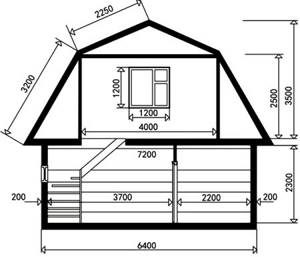
Drawing of the facade of a house with an attic
actual dimensions
What is more comfortable - an apartment or a country house? Of course, home! There are also ardent supporters of apartments, but most people still prefer to have their own house. After all, there are many advantages to this:
Examples of interesting layouts of houses with stove heating
When considering designs of houses with a stove, it is worth considering not only the size of the buildings and layout features, but also the materials used for the construction of the buildings. Not all options developed for brick buildings are suitable for wooden structures.
Small country house with veranda
This small house has one living room with an area of 15 square meters. meters and a kitchen-dining room with an area of 8 sq. meters. The project includes a small bathroom, the entrance to which is in the kitchen, and an unheated veranda.
Project of a house with stove heating (building dimensions 5*7 meters)
The heating device is located in the center of the building and heats all the interior spaces: kitchen, room and bathroom. The firebox is located on the kitchen side; it is also recommended to install a hob and oven here. If hot water is needed in the house, then the authors of the project consider the bathroom to be the best place for a water heating tank.
From the living room side, it is easy to add a false fireplace to the stove by providing a small recess in the wall. A decorative fireplace insert will not only decorate the room, but will also increase heat transfer, playing the role of traditional stoves used in the construction of Russian stoves.
Wooden house with two living rooms and a bathroom
This log house has two adjacent rooms - a bedroom and a living room, which has a kitchen-dining room. The fireplace in the wall heats all four rooms, including the hallway and bathroom. The bed is brought into the bedroom, where it serves as a resting place and increases the heat transfer of the heating device, remaining warm for a long time.
Plan of a hut with a Russian stove
There is a dryer in the hallway - it is convenient to dry wet shoes and clothes. The kitchen has a stove. For the warm season, a summer operation is provided, allowing you to use only the stove without using heating.
House layout with two bedrooms and living room
This house is designed for permanent residence and includes two bedrooms, a living room with a kitchen, a bathroom and a storage room. The stove is located in the wall and heats the kitchen-living room and both bedrooms. The bathroom is not heated, but it borders on the hallway, into which one of the stove corners is located. If a wood-burning fireplace is the main source of heat, it makes sense to increase its efficiency with ductwork.
Project of a residential building with stove heating
The kitchen is equipped with a hob and oven. There is no door in the living room, so the heat is evenly distributed throughout the house. If you plan to build a Russian stove with a stove bench, then it is best to build a trestle bed in one of the bedrooms.
Project of a brick house with two stoves
In some cases, in a large house for permanent residence, two separate stoves are installed. This building has two bedrooms, a living room and a separate kitchen. The main multi-turn heating stove is installed between the living room and the children's room. The furnace door and body of the building open into the living room, and the children's room is heated with coarse heating - this arrangement prevents carbon monoxide from entering the children's bedroom.
A second fireplace with stove and oven is located in the kitchen and heats the adults' bedroom. The design of this model can work in winter and summer - in the warm season, summer dampers are opened, through which hot gases quickly escape into the chimney.
Residential building with two heat sources
Heat comes into the hallway from the kitchen; the room is small, so it is enough to leave the door open to ensure a comfortable temperature in the hallway. There is no heat leakage to the street, since the flow of cold air is cut off by a glazed veranda.
With all the variety of ready-made designs for houses with a stove, we recommend contacting a specialist and ordering an individual plan, expressing your wishes. If you choose one of the schemes, you need to show the drawing to a professional; perhaps he will make useful adjustments and advise how to make stove heating as efficient as possible, and the house comfortable and cozy.
Related Posts
- Fire-battery 7b (thermophor)
- All about one-story houses with a basement
- Wood-burning stoves and their variety of designs
- Buleryan oven: do it yourself
- How to fold a Swedish oven with a stove
- Cast iron stove for bath Vesuvius
- Homemade Russian stove on the street under a canopy
- Houses made of kiln-dried profiled timber
- Fast and correct furnace repair
- How to make a long-burning stove yourself
- Secrets of stove makers: brick stove for a bath
- How to choose a stove for an Ermak sauna: top 7 models with descriptions of technical characteristics and customer reviews
- Types and sizes of Russian stoves: types, sizes, 5 construction recommendations
- How to install a stove in the house?
- DIY metal rocket oven
- Installing a stove in a steam room: location, fencing, protective screen
- Manufacturing and connecting a sauna stove with a water heat exchanger
- How to weld a metal sauna stove
- Do-it-yourself gas heater: options for the best homemade products
- Types of Kuznetsov furnaces and their order
- 9 types of heat-resistant tiles for fireplaces and stoves: choosing the best
- Types of stoves for the home: classification and review of equipment from the best manufacturers
- A stove with a water circuit for heating a house: features of stove heating + choosing the optimal option
- How to plaster a stove to prevent it from cracking: types of putty for stoves and execution technology
- How to make a Buleryan oven with your own hands: description and drawings
Read with this
- Fire-battery 7b (thermophor)
- All about one-story houses with a basement
- Wood-burning stoves and their variety of designs
- Buleryan oven: do it yourself
- How to fold a Swedish oven with a stove
- Cast iron stove for bath Vesuvius
- Homemade Russian stove on the street under a canopy
- Houses made of kiln-dried profiled timber
- Fast and correct furnace repair
- How to make a long-burning stove yourself
How to install a two-story hydronic heating system
A furnace with a water circuit does not differ in operating principle from a conventional solid fuel boiler: wood or coal is burned in the fuel compartment, and the released heat warms up the coolant in the exchanger. This can be ordinary water, but it is more profitable to purchase antifreeze: it will not freeze in case of temporary problems in the system, and in addition, it will not have to be changed for a long time.
A register is used as a heat exchanger - this is a type of coil through which a temperature-changing coolant passes. The register can be made of metal pipes or sheet metal, and the higher its area, the more heat it can collect and transmit.
The thickness of the walls of the register must be at least 3 mm: otherwise it will simply burn out, since the temperature in the firebox compartment will be very high. A sheet register is easier to manufacture and install; you don’t have to buy it, but make it yourself. But at the same time, the pipe design is more efficient.
Heating radiators are connected to the installed register using metal pipes, which must be placed at an angle. Water will move through them by gravity, and a circulation pump can be installed to supply it to the second floor.
The assembly diagram will be the simplest: you can use single-pipe wiring with a simple connection. After installation, you can proceed to a test run: the owner must evaluate how quickly and efficiently the stove warms up, and whether it will provide heat in the house.
The water circuit must have an expansion tank: it is located at the highest point of the system. This tank will make it possible to compensate for the expansion of water as the temperature rises. The system will work optimally, and the owner will not have to put any effort into setting it up.
